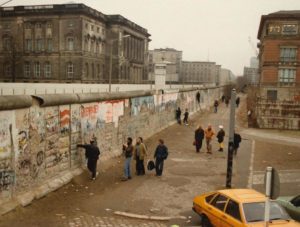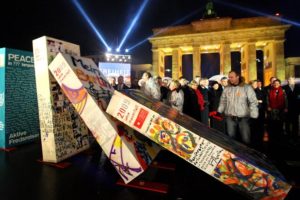Continua la collaborazione tra il liceo linguistico "Cattaneo dall'Aglio" e Redacon tramite la rubrica "Speakeasy" curata direttamente dagli studenti, dell'anno scolastico 2019-2020.
Berlin Wall anniversary

Hi everybody, today we are going to talk about how people in Germany are celebrating the 30th anniversary of the fall of the Berlin wall. Why do we want to talk about it? Because even though it might seem we are too young to know, and too far away, here on the Appennines, what happened in Germany when the wall came down can and should give everybody, young or old, German or Italian, hope for a better future.
First of all let’s have a quick look at what happened.
The construction of the Berlin wall started on 13th August 1961. It was built by the Government of East Germany to prevent people from the East from entering West Berlin, where life was considered better.
The wall surrounded West Berlin and it divided the city in two completely different parts for more than 28 years.

On 9th November 1989 the wall came down. The day of this fall was the day of reunification, the day when people felt free again. The period of subjection had finally ended.
For lots of German people the fall of the Berlin wall was the best day of their lives. For this reason the anniversary is every year an important day and Germany has planned lots of events to remember and to celebrate it.
All these are taking place at seven venues and on seven days.
The Berlin wall celebrations have started on the 4th of November and will end on 10th of November. They will be dealing with: the history of division, the struggle for freedom, the process of reunification…
There will be open-air exhibitions, festivals, markets,demonstrations.

In Alexanderplatz, for example, there will be an open-air exhibition, 3D video projections of historical pictures to allow people to go back to the time of the Peaceful Revolution.
At Brandenburg Gate there will be a big concert with the participation of lots of national and international artists whose songs and stories will be connected to the event of this important week.
Over two hundred public events will take place in Berlin: concerts of various genres, workshops, film series, readings, contemporary witness talks and discussions with journalists, historians and politicians and also guide tours through Berlin’s history.
The main highlight will be at the Brandenburg Gate on the evening of Saturday 9 November.
As regards history, in numerous Berlin museums you can travel back in time from the Middle Ages to the present. More than 7000 objects at the German Historical Museum tell the story of the German people.

The Heinrich Böll Foundation will show a projection which relates two elements: a concentrated selection of the slogans of the peaceful revolution from October and November 1989 and, as a dialogical counterpoint, the sentence that has become a meme: "This applies, I believe, from now on”.
This artistic montage will open up new associative spaces and invite people to remember and reflect.
Festivals and events:
7 Days – 7 Locations

For seven days over the course of the festival week, the story of the Peaceful Revolution and the fall of the Wall will be brought to life at the places where it unfolded: these sites will commemorate key events in the overthrow of the SED regime, the courage of those who opposed the dictatorship, and the dawn of a new and democratic era.
On Kurfürstendamm the festival will celebrate the first encounters between West and East Berliners.
Large-scale 3D video projections composed of historical pictures, animations and sound effects will reproduce the atmosphere of each site and the mood of the people at the time, inviting viewers to engage with the past by recounting the stories that unfolded at each location.
People will be able to immerse themselves in the events of that time at the original sites. The recollections of contemporary witnesses will render the exhibition’s narrative even more remarkable: their stories have been collected and curated in an extensive interview project, and will be featured in the exhibitions in the form of quotes and listening stations.

The music festival, which will take place in front of Berlin’s most important landmark, as we said before, will bring national and international artists to the stage. All songs and stories will be closely connected to the events of 1989/90.
Another special feature of the festival will be a floating art installation made up of 30.000 handwritten messages. In fact Berliners and visitors will be invited to share their own messages, wishes and hopes for the future and for the memories of the past which will be integrated into a large scale installation, known as a Skynet, that will float in the sky during the festival week.

The aim of the events is not only to commemorate the victims of the dictatorship, but also to allow people to experience the historic events of the Peaceful Revolution.
Today, in a globalised and united world, it’s hard to imagine that thirty years ago someone could have thought, realized and justified the construction of a wall that divided Berlin in two.
These events remind us that if we want to live in a united world we should stop fighting and building walls.
We would like to conclude by quoting the famous words that John. F. Kennedy said during his speech in 1963 to bring the Berlin issue to the attention of the whole world “All free men, wherever they may live, are citizens of Berlin. And therefore, as a free man, I take pride in the words “Ich bin ein Berliner!”
(Letizia Filippi, Martina Predelli e Alyssa Gregori. 5R)
*****
Traduzione
Ciao a tutti, oggi parleremo di come le persone in Germania si stanno preparando per il trentesimo anniversario della caduta del muro di Berlino. Perché vogliamo parlare di ciò? Perché nonostante possiamo sembrare troppo giovani per sapere, e troppo lontani qui negli Appennini, quello che successe in Germania quando cadde il muro di Berlino può e dovrebbe dare a tutti, giovani e anziani, tedeschi o italiani, speranza per un futuro migliore.

Il muro di Berlino non fu solo una parete fisica, fu un simbolo di terrore, paura, divisione per amici, parenti e famiglie. Il muro aveva dei buchi per vedere al di là, c’erano diversi modi per mettersi in contatto con le persone dall’altro lato, ma il giorno in cui il muro venne costruito tutto cambiò.
Il 9 novembre 1989 il muro cadde. Il giorno di questa caduta fu il giorno della riunificazione, il giorno in cui la gente si sentì di nuovo libera. Il periodo della sottomissione era finalmente terminato. Per molti tedeschi la caduta del muro di Berlino fu il giorno migliore della vita. Per questa ragione l’anniversario è ogni anno un giorno importante e adesso la Germania sta pianificando tanti eventi per ricordarlo e celebrarlo. Tutti questi eventi avranno luogo in sette sedi e in sette giorni.
Le celebrazioni del muro di Berlino iniziano il 4 novembre e si concludono il 10 novembre. Tratteranno: della storia della divisione, della lotta per la libertà, del processo di riunificazione… Ci saranno esibizioni all’aperto, festivals, mercati, dimostrazioni.
Nella Alexanderplatz, per esempio, ci sarà un’esibizione all’aperto, proiezioni video in 3D di immagini storiche che permetteranno agli spettatori di tornare indietro al tempo della Rivoluzione pacifica.

Si terranno più di duecento eventi pubblici a Berlino: concerti di vario genere, laboratori, film, letture, testimonianze contemporanee e discussioni con giornalisti, storici e politici e anche visite attraverso la storia di Berlino. L’evento principale si terrà alla Porta di Brandeburgo la sera di sabato 9 novembre.
Per quanto riguarda la storia, in molti musei di Berlino si potrà tornare indietro nel tempo dal medioevo al presente. Più di 7000 oggetti nel German Historical Museum parleranno della storia dei tedeschi. 
La Heinrich Böll Foundation mostrerà una proiezione che farà riferimento a due elementi: una concentrata selezione degli slogan della rivoluzione pacifica di Ottobre e Novembre del 1989 e, come un contrappunto dialogico, la frase che è diventata un meme: “Questo vale, credo, d’ora in poi.” Questo montaggio artistico aprirà nuovi spazi associativi e inviterà le persone a ricordare e a riflettere.
Festival e eventi: 7 giorni — 7 luoghi
Per sette giorni durante la settimana del festival, la storia della rivoluzione pacifica e della caduta del muro saranno riportate in vita nei luoghi dove si sono svolti, questi siti commemoreranno eventi fondamentali nell'abbattimento del partito di Unità Socialista della Germania, il coraggio di quelli che opposero la dittatura, e il sorgere di una nuova era democratica. Al Kurfürstendamm il festival celebrerà il primo incontro tra gli abitanti di Berlino Ovest e quelli di Berlino Est. 
Gli abitanti di Berlino e i suoi ospiti, la sera del 9 Novembre, celebreranno con un grande spettacolo alla porta di Brandeburgo.

Un’altra speciale caratteristica del festival sarà un'installazione artistica fluttuante costituita da 30.000 messaggi scritti a mano.
Infatti, i Berlinesi e i visitatori saranno invitati a condividere i loro messaggi, desideri, speranze per il futuro e memorie del passato che verranno integrati in un’installazione su larga scala , chiamata Skynet, che fluttuerà in cielo durante la settimana di festa.

Oggi, in un mondo unito e globalizzato, è difficile immaginare che trent’anni fa qualcuno avrebbe potuto pensare, realizzare e giustificare la costruzione del muro che ha diviso Berlino in due.
Questi eventi ci ricordano che se vogliamo vivere in un mondo unito dovremmo smettere di combattere e di costruire muri.
Vorremmo concludere citando una delle migliori frasi che John. F. Kennedy disse durante il suo discorso nel 1963 per portare la questione berlinese in tutto il mondo: “ Tutti gli uomini liberi, ovunque si trovino, sono cittadini di Berlino. Come uomo libero, quindi, mi vanto di dire: sono un Berlinese!”
(Letizia Filippi, Martina Predelli e Alyssa Gregori. 5R)
Bibliografia: www.visitberlin.de; www.berlin.de; www.ap.org ; www.wikipedia.org ; about.visitberlin.de sites.google.com/la-guerra-fredda







